
The Climate Change Pact agreed by leaders at the end of COP26 in Glasgow went further than many pessimists had forecast, but not far enough to meet the goal of keeping global warming to 1.5°C above pre-industrial levels. The Pact states that:
limiting global warming to 1.5°C requires rapid, deep and sustained reductions in global greenhouse gas emissions, including reducing global carbon dioxide emissions by 45 per cent by 2030 relative to the 2010 level and to net zero around mid-century, as well as deep reductions in other greenhouse gases.
So how far would the commitments made in Glasgow restrict global warming and what actions need to be put in place to meet these commitments?
Short-term commitments and long-term goals
According to Climate Action Tracker, the short-term commitments to action that countries set out would cause global warming of 2.4°C by the end of the century, the effects of which would be calamitous in terms of rising sea levels and extreme weather.
However, long-term commitments to goals, as opposed to specific actions, if turned into specific actions to meet the goals would restrict warming to around 1.8°C by the end of the century. These long-term goals include reaching net zero emissions by certain dates. For the majority of the 136 countries agreeing to reach net zero, the date they set was 2050, but for some developing countries, it was later. China, Brazil, Indonesia, Russia, Nigeria, Sri Lanka and Saudi Arabia, for example, set a date of 2060 and India of 2070. Some countries set an earlier target and others, such as Benin, Bhutan, Cambodia, Guyana, Liberia and Madagascar, claimed they had already reached zero net emissions.
Despite these target dates, Climate Action Tracker argues that only 6 per cent of countries pledging net zero have robust policies in place to meet the targets. The problem is that actions are required by firms and individuals. They must cut their direct emissions and reduce the consumption of products whose production involved emissions.
 Governments can incentivise individuals and firms through emissions and product taxes, through carbon pricing, through cap-and-trade schemes, through subsidies on green investment, production and consumption, through legal limits on emissions, through trying to change behaviour by education campaigns, and so on. In each case, the extent to which individuals and firms will respond is hard to predict. People may want to reduce global warming and yet be reluctant to change their own behaviour, seeing themselves as too insignificant to make any difference and blaming big business, governments or rich individuals. It is important, therefore, for governments to get incentive mechanisms right to achieve the stated targets.
Governments can incentivise individuals and firms through emissions and product taxes, through carbon pricing, through cap-and-trade schemes, through subsidies on green investment, production and consumption, through legal limits on emissions, through trying to change behaviour by education campaigns, and so on. In each case, the extent to which individuals and firms will respond is hard to predict. People may want to reduce global warming and yet be reluctant to change their own behaviour, seeing themselves as too insignificant to make any difference and blaming big business, governments or rich individuals. It is important, therefore, for governments to get incentive mechanisms right to achieve the stated targets.
Let us turn to some specific targets specified in the Climate Change Pact.
Phasing out fossil fuel subsidies
Paragraph 20 of the Climate Change Pact
Calls upon Parties to accelerate … efforts towards the … phase-out of inefficient fossil fuel subsidies, while providing targeted support to the poorest and most vulnerable in line with national circumstances and recognizing the need for support towards a just transition.
Production subsidies include tax breaks or direct payments that reduce the cost of producing coal, oil or gas. Consumption subsidies cut fuel prices for the end user, such as by fixing the price at the petrol pump below the market rate. They are often justified as a way of making energy cheaper for poorer people. In fact, they provide a bigger benefit to wealthier people, who are larger users of energy. A more efficient way of helping the poor would be through benefits or general tax relief. Removing consumption subsidies in 32 countries alone would, according to International Institute for Sustainable Development, cut greenhouse gas emission by an average of 6 per cent by 2025.
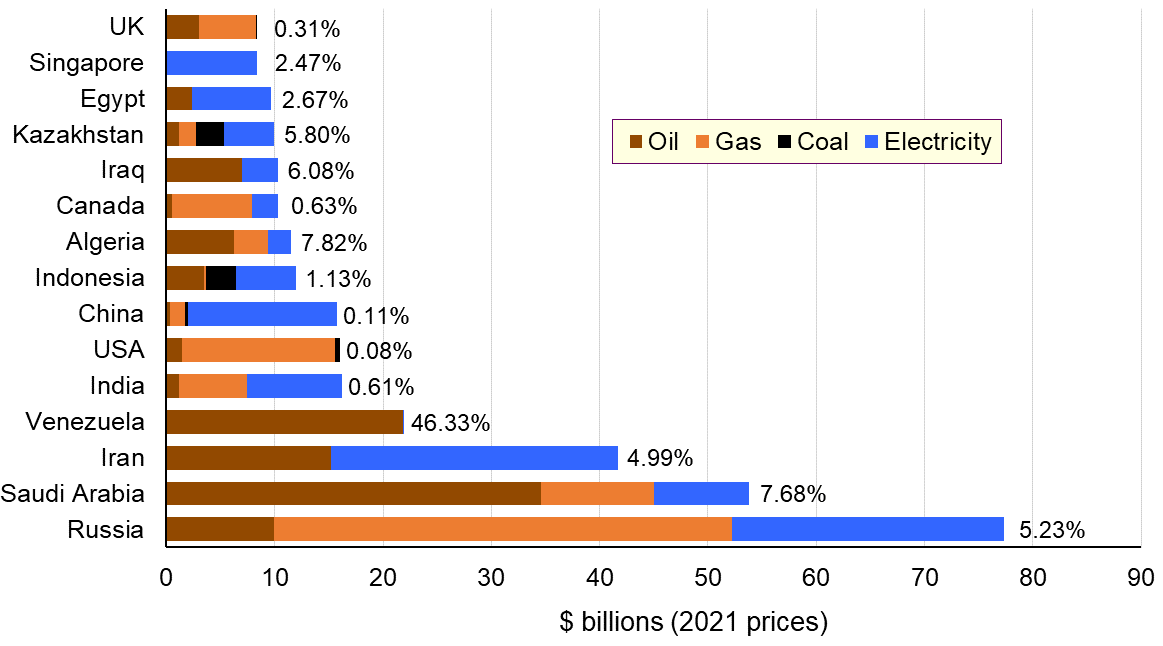 The chart shows the 15 countries providing the largest amount of support to fossil fuel industries in 2020 (in 2021 prices). The bars are in billions of dollars and the percentage of GDP is also given for each country. Subsidies include both production and consumption subsidies. (Click here for a PowerPoint of the chart.) In addition to the direct subsidies shown in the chart, there are the indirect costs of subsidies, including pollution, environmental destruction and the impact on the climate. According to the IMF, these amounted to $5.4 trillion in 2020.
The chart shows the 15 countries providing the largest amount of support to fossil fuel industries in 2020 (in 2021 prices). The bars are in billions of dollars and the percentage of GDP is also given for each country. Subsidies include both production and consumption subsidies. (Click here for a PowerPoint of the chart.) In addition to the direct subsidies shown in the chart, there are the indirect costs of subsidies, including pollution, environmental destruction and the impact on the climate. According to the IMF, these amounted to $5.4 trillion in 2020.
But getting countries to agree on a path to cutting subsidies, when conditions vary enormously from one country to another, proved very difficult.
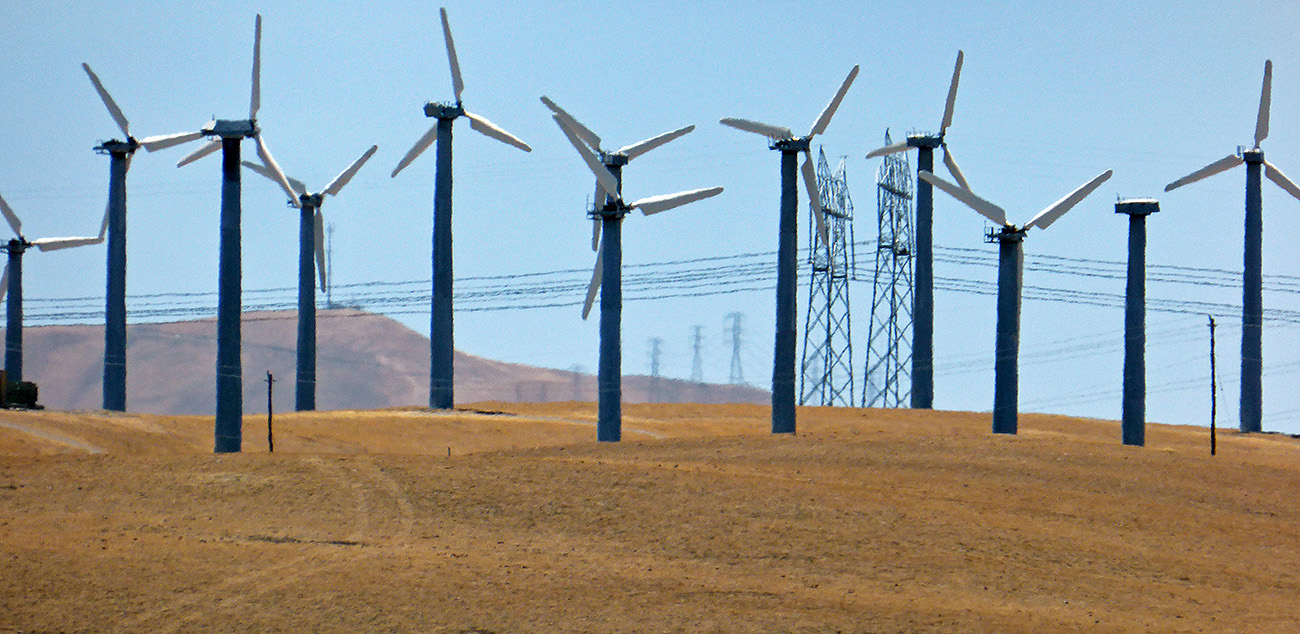 The first draft of the conference agreement called for countries to ‘to accelerate the phasing-out of coal and subsidies for fossil fuels’. But, after objections from major coal producing countries, such as China, India and Australia, this was weakened to calling on countries to accelerate the shift to clean energy systems ‘by scaling up the deployment of clean power generation and energy efficiency measures, including accelerating efforts towards the phasedown of unabated coal power and phase-out of inefficient fossil fuel subsidies’. (‘Unabated’ coal power refers to power generation with no carbon capture.) Changing ‘phasing-out’ to ‘the phasedown’ caused consternation among many delegates who saw this as a substantial weakening of the drive to end the use of coal.
The first draft of the conference agreement called for countries to ‘to accelerate the phasing-out of coal and subsidies for fossil fuels’. But, after objections from major coal producing countries, such as China, India and Australia, this was weakened to calling on countries to accelerate the shift to clean energy systems ‘by scaling up the deployment of clean power generation and energy efficiency measures, including accelerating efforts towards the phasedown of unabated coal power and phase-out of inefficient fossil fuel subsidies’. (‘Unabated’ coal power refers to power generation with no carbon capture.) Changing ‘phasing-out’ to ‘the phasedown’ caused consternation among many delegates who saw this as a substantial weakening of the drive to end the use of coal.
Another problem is in defining ‘inefficient’ subsidies. Countries are likely to define them in a way that suits them.
The key question was the extent to which countries would actually adopt such measures and what the details would be. Would they be strong enough? This remained to be seen.
As an article in the journal, Nature, points out:
There are three main barriers to removing production subsidies … First, fossil-fuel companies are powerful political groups. Second, there are legitimate concerns about job losses in communities that have few alternative employment options. And third, people often worry that rising energy prices might depress economic growth or trigger inflation.
The other question with the phasing out of subsidies is how and how much would there be ‘targeted support to the poorest and most vulnerable in line with national circumstances’.
Financial support for developing countries
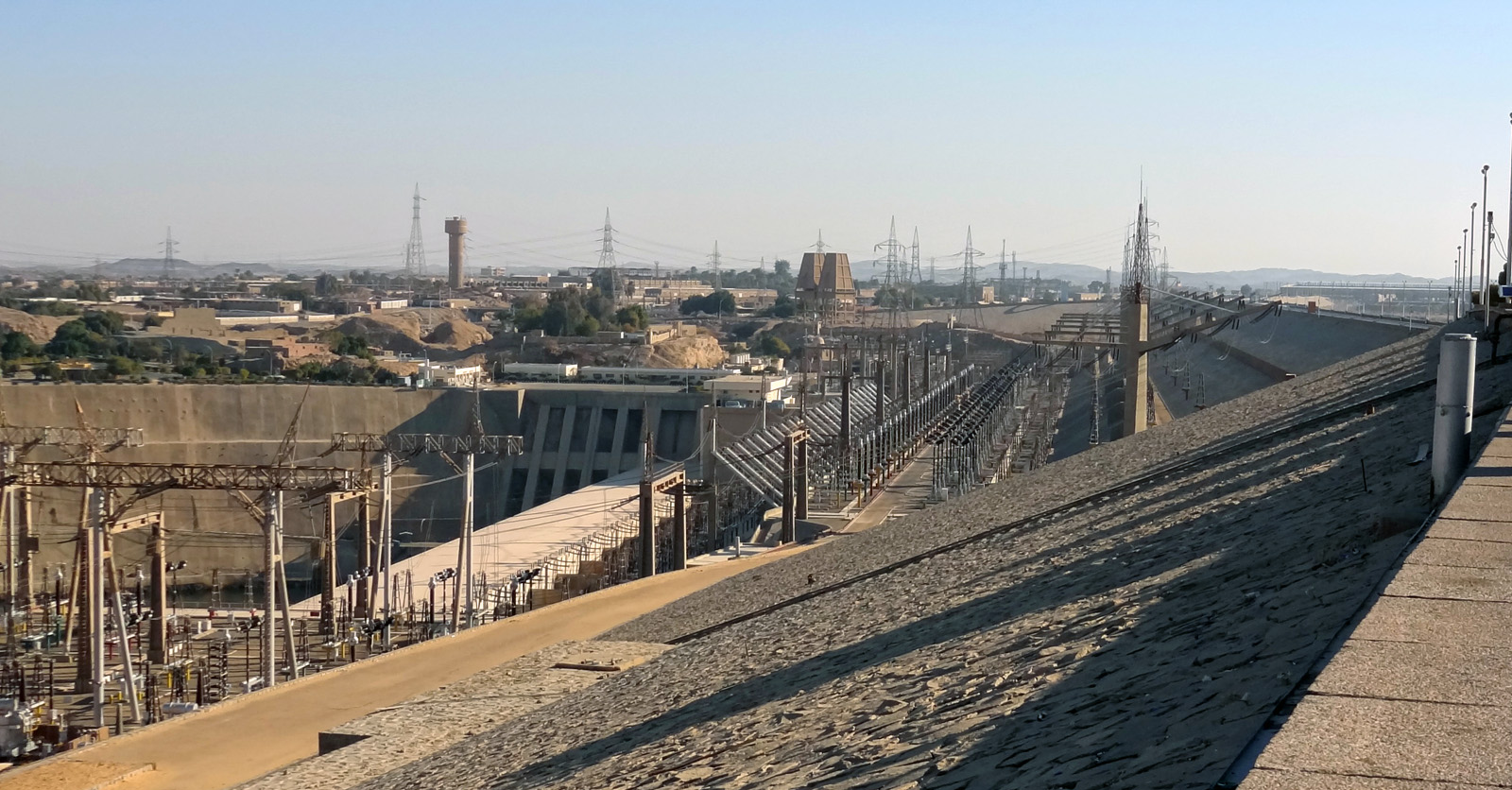 Transitioning to a low-carbon economy and investing in measures to protect people from rising sea levels, floods, droughts, fires, etc. costs money. With many developing countries facing serious financial problems, especially in the light of measures to support their economies and healthcare systems to mitigate the effects of COVID-19, support is needed from the developed world.
Transitioning to a low-carbon economy and investing in measures to protect people from rising sea levels, floods, droughts, fires, etc. costs money. With many developing countries facing serious financial problems, especially in the light of measures to support their economies and healthcare systems to mitigate the effects of COVID-19, support is needed from the developed world.
In the COP21 Paris Agreement in 2015, developed countries pledged $100 billion by 2020 to support mitigation of and adaptation to the effects of climate change by developing countries. But the target was not reached. The COP26 Pact urged ‘developed country Parties to fully deliver on the $100 billion goal urgently and through to 2025’. It also emphasised the importance of transparency in the implementation of their pledges. The proposal was also discussed to set up a trillion dollar per year fund from 2025, but no agreement was reached.
It remains to be seen just how much support will be given.
Then there was the question of compensating developing countries for the loss and damage which has already resulted from climate change. Large historical polluters, such as the USA, the UK and various EU countries, were unwilling to agree to a compensation mechanism, fearing that any recognition of culpability could make them open to lawsuits and demands for financial compensation.
Other decisions
- More than 100 countries at the meeting agreed to cut global methane emissions by at least 30 per cent from 2020 levels by 2030. Methane is a more powerful but shorter-living greenhouse gas than carbon. It is responsible for about a third of all human-generated global warming. China, India and Russia, however, did not sign up.
 Again, more than 100 countries agreed to stop deforestation by 2030. These countries include Indonesia and Brazil, which has been heavily criticised for allowing large parts of the Amazon rainforest to be cleared for farming, such that the Amazon region in recent years has been a net emitter of carbon from the felling and burning of trees. The pledge has been met with considerable cynicism, however, as it unclear how it will be policed. Much of the deforestation around the world is already illegal but goes ahead anyway.
Again, more than 100 countries agreed to stop deforestation by 2030. These countries include Indonesia and Brazil, which has been heavily criticised for allowing large parts of the Amazon rainforest to be cleared for farming, such that the Amazon region in recent years has been a net emitter of carbon from the felling and burning of trees. The pledge has been met with considerable cynicism, however, as it unclear how it will be policed. Much of the deforestation around the world is already illegal but goes ahead anyway.- A mechanism for trading carbon credits was agreed. This allows countries which plant forests or build wind farms to earn credits. However, it may simply provide a mechanism for rich countries and businesses to keep emitting as usual by buying credits.
- Forty-five countries pledged to invest in green agricultural practices to make farming more sustainable.
- Twenty-two countries signed a declaration to create zero-emission maritime shipping routes.
- The USA and China signed a joint declaration promising to boost co-operation over the next decade on various climate actions, including reducing methane emissions, tackling deforestation and regulating decarbonisation.
 Blah, blah, blah or real action?
Blah, blah, blah or real action?
Many of the decisions merely represent targets. What is essential is for countries clearly to spell out the mechanisms they will use for achieving them. So far there is too little detail. It was agreed, therefore, to reconvene in a year’s time at COP27 in Egypt. Countries will be expected to spell out in detail what actions they are taking to meet their emissions targets and other targets such as ending deforestation and reducing coal-fired generation.
Articles
- COP26 ended with the Glasgow Climate Pact. Here’s where it succeeded and failed
CNN, Angela Dewan and Amy Cassidy (14/11/21)
- Good COP, Bad COP: Separating heat from light at the climate summit
Ing, Samuel Abettan, Gerben Hieminga and Coco Zhang (15/11/21)
- COP26: What was agreed at the Glasgow climate conference?
BBC News (15/11/21)
- Five Things You Need to Know About The New Glasgow Climate Pact
The Conversation, Simon Lewis and Mark Maslin (13/11/21)
- Infographic: What has your country pledged at COP26?
Aljazeera, Hanna Duggal (14/11/21)
- Cop26: world on track for disastrous heating of more than 2.4C, says key report
The Guardian, Fiona Harvey (9/11/21)
- Cop26 took us one step closer to combating the climate crisis
The Guardian, Christiana Figueres (15/11/21)
- After the failure of Cop26, there’s only one last hope for our survival
The Guardian, George Monbiot (14/11/21)
- Why fossil fuel subsidies are so hard to kill
Nature, Jocelyn Timperley (20/10/21)
- The COP26 blah blah blah detector
Rappler, Elpidio Peria (16/11/21)
Podcasts
Videos
Report
Document
Questions
- What were the main achievements of COP26?
- What were the main failings of COP26?
- How can people be incentivised to reduce their direct and indirect greenhouse gas emissions?
- How is game theory relevant to understanding the difficulties in achieving global net zero emissions?
- Should developing countries be required to give up coal power?
- If the world is to achieve net zero greenhouse gas emissions, should all countries achieve net zero or should some countries achieve net negative emissions to allow others to continue with net positive emissions (albeit at a lower level)?
 Many economists argue that the most effective policy for dealing with climate change is carbon pricing. This reduces greenhouse gas (GHG) emissions in a way that minimises the costs to the economy.
Many economists argue that the most effective policy for dealing with climate change is carbon pricing. This reduces greenhouse gas (GHG) emissions in a way that minimises the costs to the economy.
For the policy to work effectively it is important that the price per tonne of CO2 equivalent (CO2e) does not vary with the activity that causes the emissions. In other words, whether you drive a car, heat your house using gas or travel by air, the GHGs you create need to be priced at a unified rate.
Governments can introduce carbon pricing in two different ways – cap-and-trade schemes and carbon taxes.
With a cap-and-trade policy, emission allowances are either issued or sold to the organisations covered by the scheme. They must accumulate enough of these allowances to match the actual level of emissions they produce or pay a large fine. After the initial allocation, allowances can be bought and sold in a secondary market and prices can be quite volatile.
With a carbon tax, the government directly sets the price of GHGs through the tax rate but has less control over the quantity of emissions.
Policy in the UK
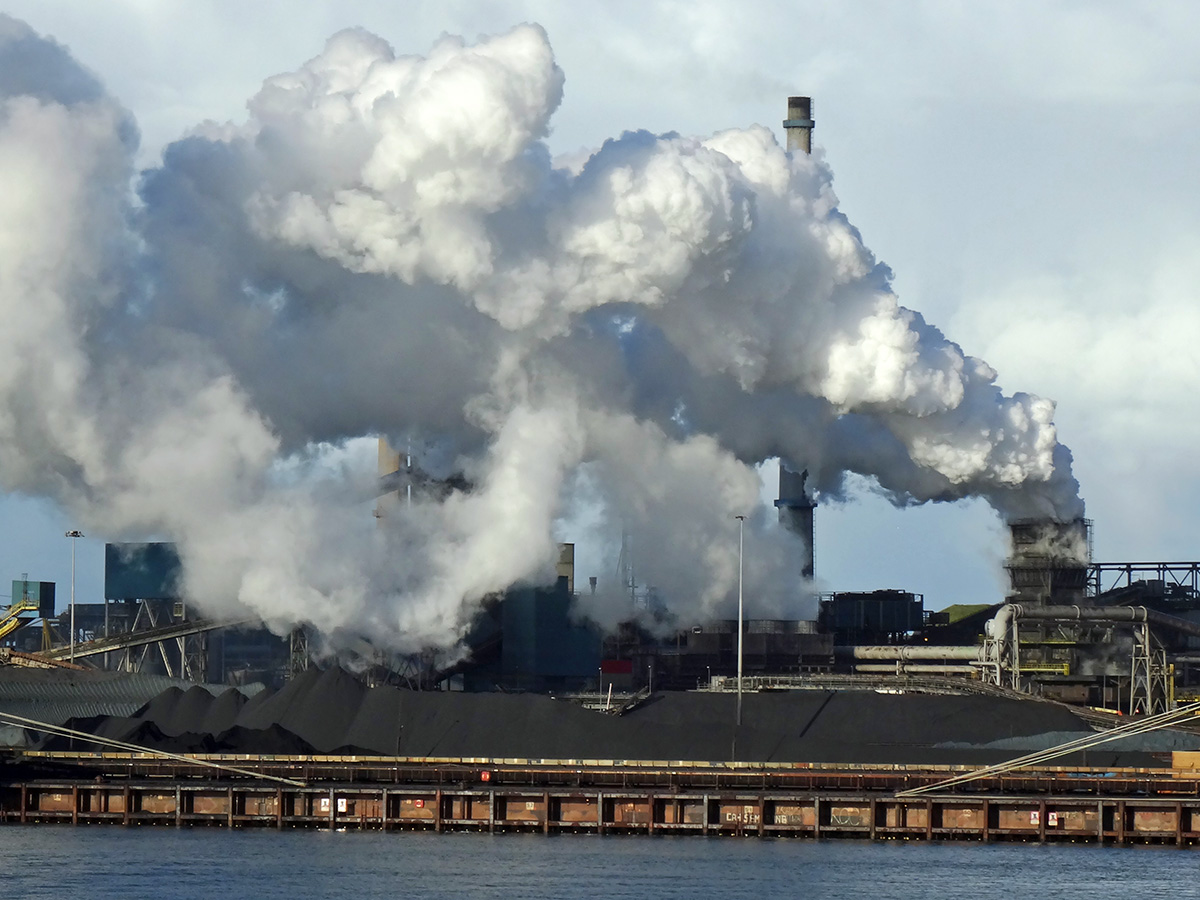 The UK Emissions Trading Scheme – an example of a cap-and-trade scheme – clearly places a price on GHG emissions. As this price is determined by market forces it can vary on a daily basis. The scheme applies to electricity generation and other energy-intensive industries that account for approximately 30 per cent of all emissions.
The UK Emissions Trading Scheme – an example of a cap-and-trade scheme – clearly places a price on GHG emissions. As this price is determined by market forces it can vary on a daily basis. The scheme applies to electricity generation and other energy-intensive industries that account for approximately 30 per cent of all emissions.
Although the UK does not have a specific carbon tax, it does have a number of different taxes that have an impact on the environment. Some of these have stated environmental objectives (e.g. the Climate Change Levy) while the main rationale for others is to raise revenue (fuel duty).
The tax rates are typically set on the output or consumption of the good rather than on emissions. For example, the Climate Change Levy applies to businesses’ use of electricity, gas and coal rather than the emissions the energy generates. Fuel duty depends on the amount of petrol consumed rather than the emissions the burning of that fuel generates. Clearly, emissions will tend to rise in proportion to the consumption/production of the good, but the relationship will not be precise.
The structure of VAT also influences emissions. The standard rate of VAT in the UK is 20 per cent. However, a lower level is applied to some goods/services that produce significant emissions. For example, the rate on household consumption of gas is 5 per cent while commercial passenger flights are zero rated. These lower tax rates are an implicit subsidy for the people who consume these goods/services. It makes them cheaper relative to the price of other goods.
Impact of the policies
Researchers from the Institute for Fiscal Studies have recently tried to analyse the impact of this complex range of policies on the price of carbon. The results indicate wide variations depending on the activity that causes the emissions.
One of the most significant differences is between gas and electricity. For example, non-energy-intensive businesses pay a price of £229.10 per tonne of CO2e from electricity generation but only £30.50 per tonne from burning gas. The response to the incentives this creates is unsurprising. One of the biggest contributing factors to the fall in territorial emissions in the UK has come from the decarbonisation of electricity supply: i.e. the switch away from coal-fired generation.
 The impact of government policy on UK households creates quite perverse incentives. Because of the lower rates of VAT, families receive an implicit subsidy of £24 per tonne CO2e when they use gas to heat their homes. When they use electricity, the source of energy that generates less emissions, they face a positive price of £137 per tonne of CO2e. Once again, the response to these incentives is unsurprising. Household emissions only fell by a relatively small amount between 1990 and 2018 because of the continued use of gas for heating and cooking.
The impact of government policy on UK households creates quite perverse incentives. Because of the lower rates of VAT, families receive an implicit subsidy of £24 per tonne CO2e when they use gas to heat their homes. When they use electricity, the source of energy that generates less emissions, they face a positive price of £137 per tonne of CO2e. Once again, the response to these incentives is unsurprising. Household emissions only fell by a relatively small amount between 1990 and 2018 because of the continued use of gas for heating and cooking.
Unsurprisingly many commentators have referred to carbon pricing in the UK as a confusing mess and have called for a unified rate across all activities to minimise the costs to the economy. Another important issue is the level at which a new unified rate is set. Some research by the Department for Business, Energy and Industrial Strategy suggests that the figure would have to be set between £122 and £36 per tonne of CO2e in order for the UK to reach its target of net zero emissions by 2050.
A higher unified rate would also create another problem – the distributional impact. Poorer households spend a much greater share of their income on electricity, heating and food and so would be disproportionately affected by the policy. For the policy to be politically acceptable, the government will need to find an effective way to compensate these groups.
Articles
Report
Questions
- Outline the difference between territorial and consumption emissions.
- Using the concepts of rivalry and excludability, explain why GHGs and the climate change they cause are an example of market failure.
- Discuss the main differences between cap-and trade schemes and carbon emission taxes.
- Explain why a unified carbon price would minimise the costs to the economy of reducing the level of GHG emissions.
- Discuss some of the potential limitations of introducing carbon pricing and explain why some countries are considering the implementation of a Carbon Border Adjustment mechanism.
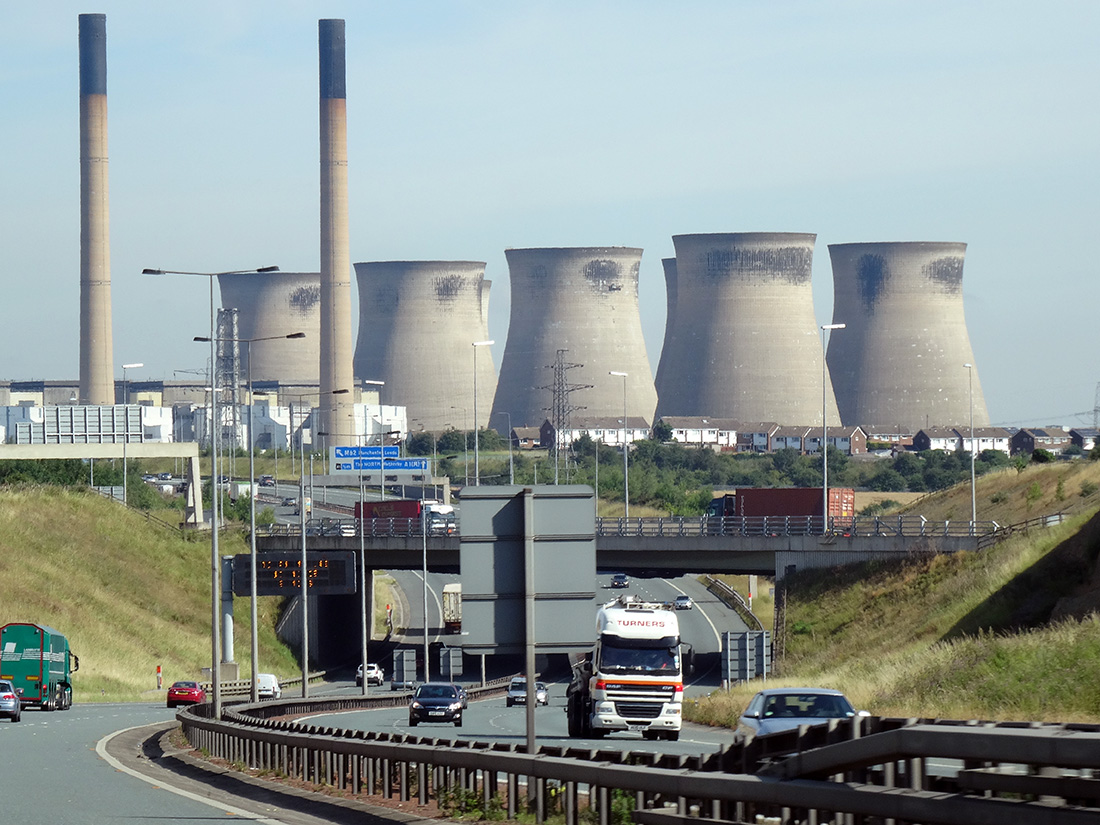 With the growing recognition of the global climate emergency (see also), attention is being increasingly focused on policies to tackle global warming.
With the growing recognition of the global climate emergency (see also), attention is being increasingly focused on policies to tackle global warming.
In the October version of its journal, Fiscal Monitor, the IMF argues that carbon taxes can play a major part in meeting the goal of achieving net zero carbon emissions by 2050 or earlier.
As the blog accompanying the journal states:
Global warming has become a clear and present threat. Actions and commitments to date have fallen short. The longer we wait, the greater the loss of life and damage to the world economy. Finance ministers must play a central role to champion and implement fiscal policies to curb climate change. To do so, they should reshape the tax system and fiscal policies to discourage carbon emissions from coal and other polluting fossil fuels.
The effect of a carbon tax on production
The argument is that carbon emissions represent a massive negative externality, where the costs are borne largely by people other than the emitters. Taxes can internalise these externalities. The effect would be to raise the price of carbon-emitting activities and reduce the quantity consumed and hence produced.
The diagram illustrates the argument. It takes the case of carbon emissions from coal-fired electricity generation in a large country. To keep the analysis simple, it is assumed that all electricity in the country is generated from coal-fired power stations and that there are many such power stations, making the market perfectly competitive.
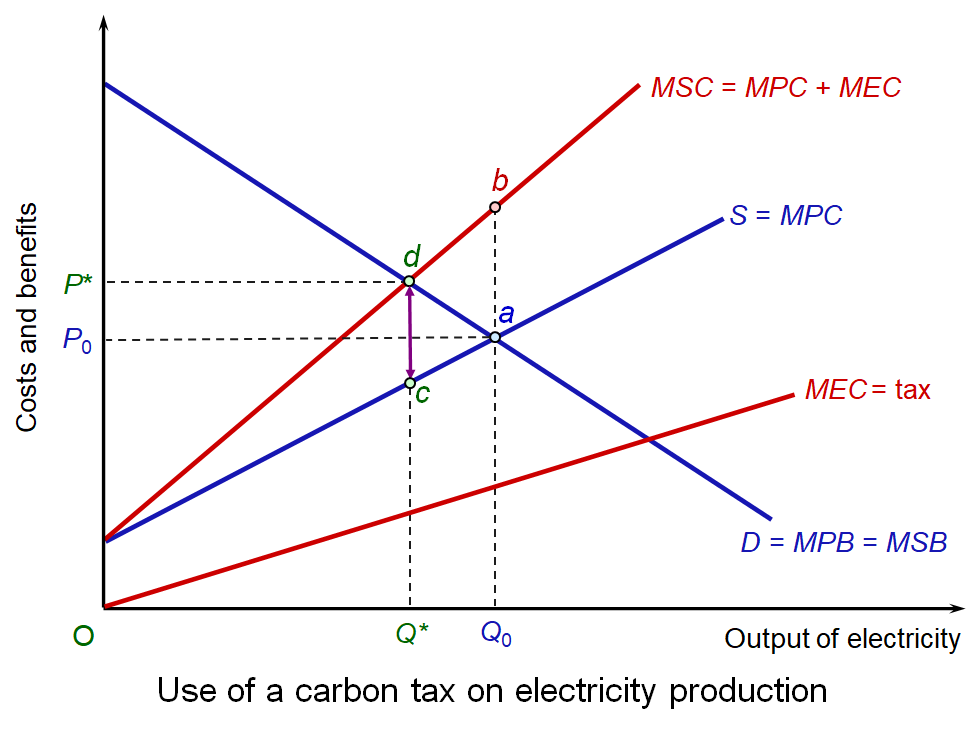 It is assumed that all the benefits from electricity production accrue solely to the consumers of electricity (i.e. there are no external benefits from consumption). Marginal private and marginal social benefits of the production of electricity are thus the same (MPB = MSB). The curve slopes downwards because, with a downward-sloping demand for electricity, higher output results in a lower marginal benefit (diminishing marginal utility).
It is assumed that all the benefits from electricity production accrue solely to the consumers of electricity (i.e. there are no external benefits from consumption). Marginal private and marginal social benefits of the production of electricity are thus the same (MPB = MSB). The curve slopes downwards because, with a downward-sloping demand for electricity, higher output results in a lower marginal benefit (diminishing marginal utility).
Competitive market forces, with producers and consumers responding only to private costs and benefits, will result in a market equilibrium at point a in the diagram: i.e. where demand equals supply. The market equilibrium price is P0 while the market equilibrium quantity is Q0. However the presence of external costs in production means that MSC > MPC. In other words, MEC = b – a.
The socially optimal output would be Q* where P = MSB = MSC, achieved at the socially optimal price of P*. This is illustrated at point d and clearly shows how external costs of production in a perfectly competitive market result in overproduction: i.e. Q0 > Q*. From society’s point of view, too much electricity is being produced and consumed.
If a carbon tax of d – c is imposed on the electricity producers, it will now be in producers’ interests to produce at Q*, where their new private marginal costs (including tax) equals their marginal private benefit.
Assessing the benefits of carbon taxes
The diagram shows the direct effect on production of electricity. With widespread carbon taxes, there would be similar direct effects on other industries that emit carbon, and also on consumers, faced with higher fuel prices. In the UK, for example, there are currently higher taxes on high-emissions vehicles than on low-emissions ones.
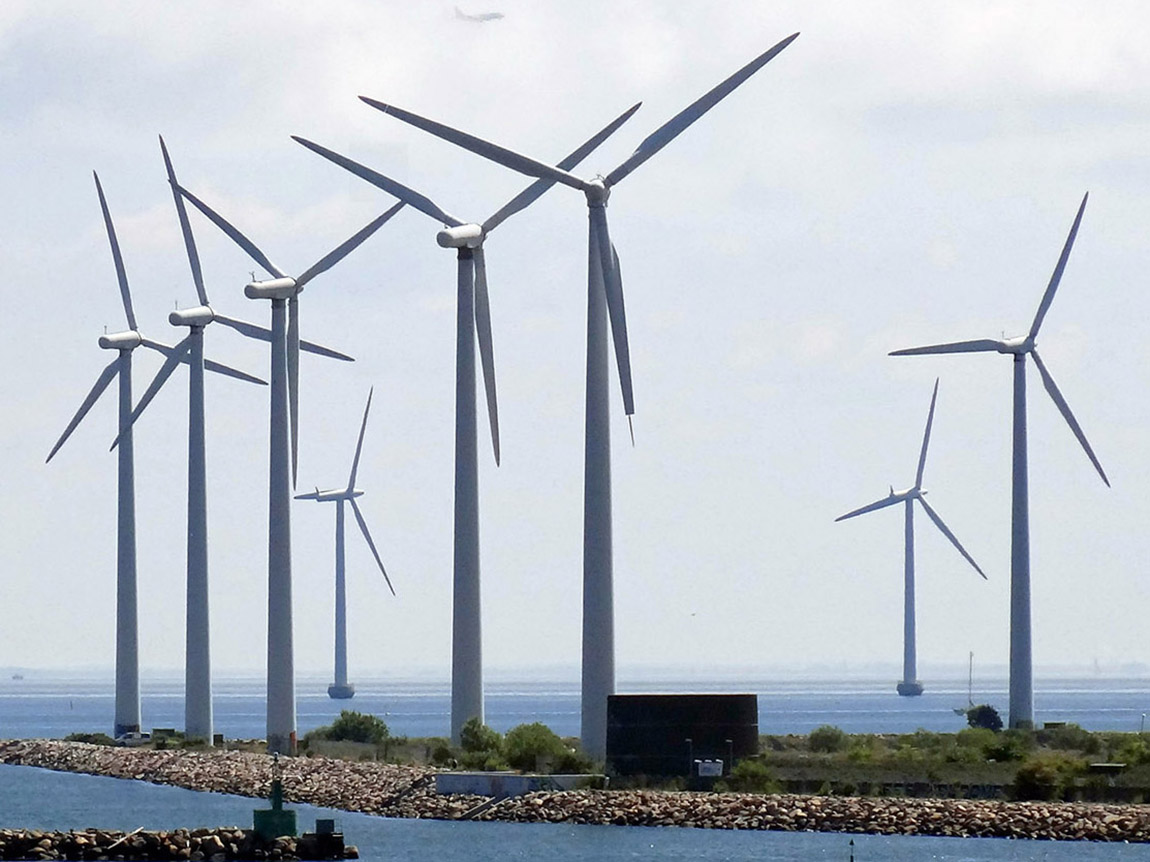 However, there are other effects of carbon taxes which contribute to the reduction in carbon emissions over the longer term. First, firms will have an incentive to invest in green energy production, such as wind, solar and hydro. Second, it will encourage R&D in green energy technology. Third, consumers will have an incentive to use less electricity by investing in more efficient appliances and home insulation and making an effort to turn off lights, the TV, computers and so on.
However, there are other effects of carbon taxes which contribute to the reduction in carbon emissions over the longer term. First, firms will have an incentive to invest in green energy production, such as wind, solar and hydro. Second, it will encourage R&D in green energy technology. Third, consumers will have an incentive to use less electricity by investing in more efficient appliances and home insulation and making an effort to turn off lights, the TV, computers and so on.
People may object to paying more for electricity, gas and motor fuel, but the tax revenues could be invested in cheaper clean public transport, home insulation and public services generally, such as health and education. This could be part of a policy of redistribution, with the tax revenues being spent on alleviating poverty. Alternatively, other taxes could be cut.
The IMF estimates that to restrict global warming to 2°C (a target seen as too modest by many environmentalists), large emitting countries ‘should introduce a carbon tax set to rise quickly to $75 a ton in 2030’.
This would mean household electric bills would go up by 43 per cent cumulatively over the next decade on average – more in countries that still rely heavily on coal in electricity generation, less elsewhere. Gasoline would cost 14 percent more on average.
It gives the example of Sweden, which has a carbon tax of $127 per ton. This has resulted in a 25% reduction in emissions since 1995, while the economy has expanded 75% since then.
Limits of carbon taxes
Although carbon taxes can make a significant contribution to combatting global warming, there are problems with their use.
First, it may be politically popular for governments not to impose them, or raise them, with politicians arguing that they are keen to help ‘struggling motorists’ or poor people ‘struggling to keep their homes warm’. In the UK, successive governments year after year have chosen not to raise road fuel taxes, despite a Fuel Price Escalator (replaced in 2011 by a Fuel Duty Stabiliser) designed to raise fuel taxes each year by more than inflation. Also, governments fear that higher energy prices would raise costs for their country’s industries, thereby damaging exports.
Second, it is difficult to measure the marginal external costs of CO2 emissions, which gives ammunition to those arguing to keep taxes low. In such cases it may be prudent, if politically possible, to set carbon taxes quite high.
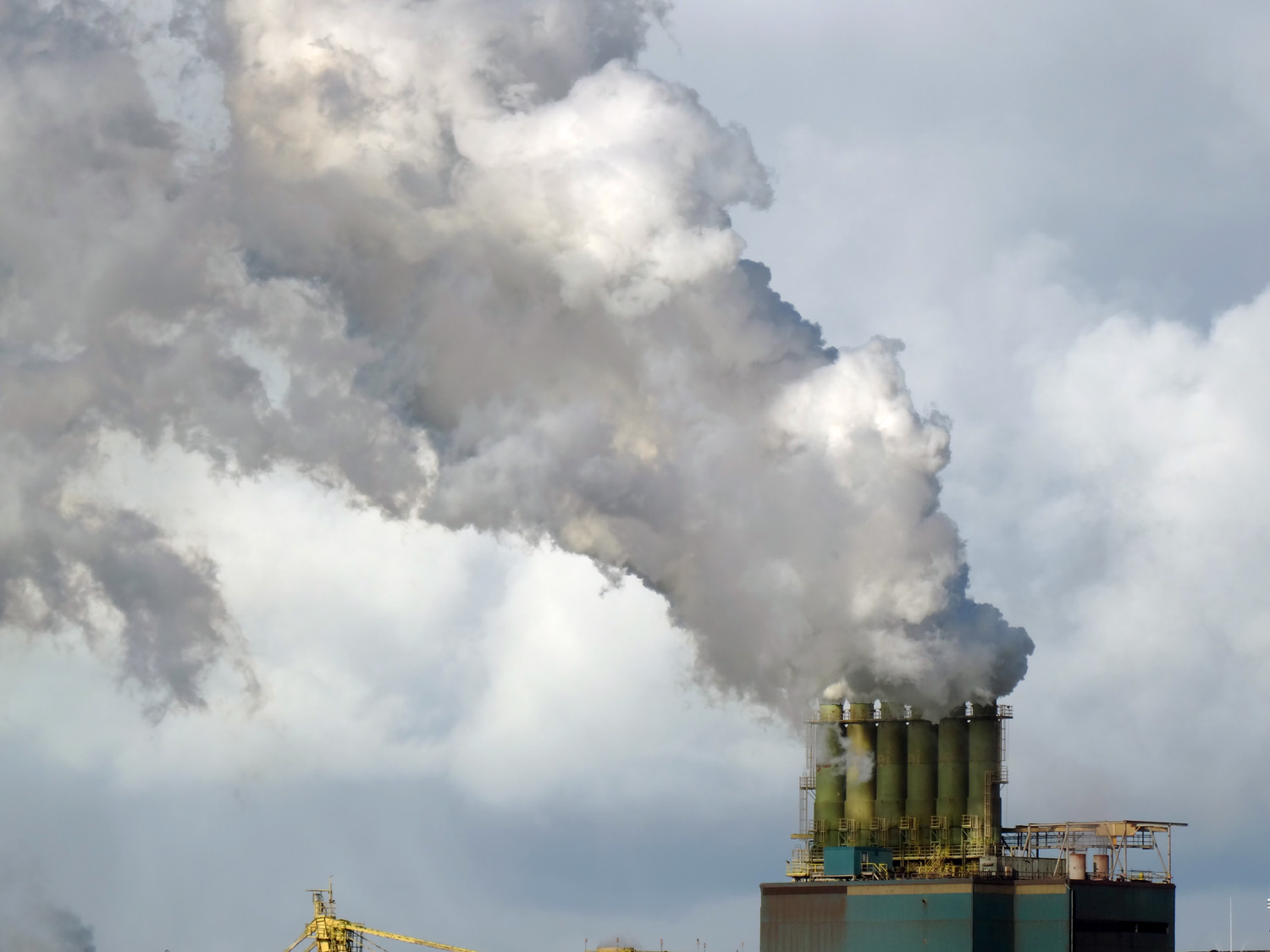 Third, they should not be seen as a sufficient policy on their own, but as just part of the solution to global warming. Legislation to prevent high emissions can be another powerful tool to prevent activities that have high carbon emissions. Examples include banning high-emission vehicles; a requirement for coal-fired power stations and carbon emitting factories to install CO2 scrubbers (filters); and tougher planning regulations for factories that emit carbon. Education to encourage people to cut their own personal use of fossil fuels is another powerful means of influencing behaviour.
Third, they should not be seen as a sufficient policy on their own, but as just part of the solution to global warming. Legislation to prevent high emissions can be another powerful tool to prevent activities that have high carbon emissions. Examples include banning high-emission vehicles; a requirement for coal-fired power stations and carbon emitting factories to install CO2 scrubbers (filters); and tougher planning regulations for factories that emit carbon. Education to encourage people to cut their own personal use of fossil fuels is another powerful means of influencing behaviour.
A cap-and-trade system, such as the European Emissions Trading Scheme would be an alternative means of cutting carbon efficiently. It involves setting quotas for emissions and allowing firms which manage to cut emissions to sell their surplus permits to less efficient firms. This puts a price pressure on firms to be more efficient. But the quotas (the ‘cap’) must be sufficiently tight if emissions are going to be cut to desired levels.
But, despite being just one possible policy, carbon taxes can make a significant contribution to combatting global warming.
Articles
 Fiscal Policies to Curb Climate Change
Fiscal Policies to Curb Climate ChangeIMF blog, Vitor Gaspar, Paolo Mauro, Ian Parry and Catherine Pattillo (10/10/19)
- Energy bills will have to rise sharply to avoid climate crisis, says IMF
The Guardian, Larry Elliott (10/10/19)
- Huge global carbon tax hike needed in next 10 years to head off climate disaster, says IMF
Independent, Chris Mooney and Andrew Freedman (11/10/19)
- World urgently needs to quicken steps to reduce global warming – IMF
Reuters, Lindsay Dunsmuir (10/10/19)
- The Case for a Goldilocks Carbon Tax
Forbes, Roger Pielke (13/9/19)
- The world needs a massive carbon tax in just 10 years to limit climate change, IMF says
Washington Post, Chris Mooney and Andrew Freedman (10/10/19)
- People like the idea of a carbon tax – if the money is put to good use
New Scientist, Michael Le Page (18/9/19)
- The IMF thinks carbon taxes will stop the climate crisis. That’s a terrible idea.
The Guardian, Kate Aronoff (12/10/19)
- Firms ignoring climate crisis will go bankrupt, says Mark Carney
The Guardian, Damian Carrington (13/10/19)
- How central banks can tackle climate change
Financial Times, The editorial board (31/10/19)
- World Economic Forum: Climate change action needed to avoid societal ‘collapse’ says minister
The National, UAE, Anna Zacharias (3/11/19)
- Riots and trade wars: Why carbon taxes will not solve climate crisis
Recharge, Leigh Collins (31/10/19) (Part 1)
- The plethora of effective alternatives to carbon pricing
Recharge, Leigh Collins (31/10/19) (Part 2)
- Are these the real reasons why Big Oil wants a carbon tax?
Recharge, Leigh Collins (31/10/19) (Part 3)
- Do we need carbon taxes in an era of cheap renewables?
Recharge, Leigh Collins (31/10/19) (Part 4)
Report
- How to Mitigate Climate Change
IMF Fiscal Monitor, Ian Parry (team leader), Thomas Baunsgaard, William Gbohoui, Raphael Lam, Victor Mylonas, Mehdi Raissi, Alpa Shah and Baoping Shang (October 2019)
Questions
- Draw a diagram to show how subsidies can lead to the optimum output of green energy.
- What are the political problems in introducing or raising carbon taxes? Examine possible solutions to these problems
- Choose two policies for reducing carbon emissions other than using carbon taxes? Compare their effectiveness with carbon taxes.
- How is game theory relevant to getting international agreement on cutting greenhouse gas emissions? Why is there likely to be a prisoners’ dilemma problem in reaching and sticking to such agreements? How might the problem of a prisoners’ dilemma be overcome in such circumstances?
There has been much criticism of the European Emissions Trading Scheme, the world’s most significant cap-and-trade (tradable permits) scheme for curbing greenhouse gas emissions. The main criticism is that the scheme has failed to make significant cuts in pollution. The cap was so loose in the first phase (2005–07) that by the end of this period, carbon was trading for as little as €0.02 per tonne. Although the cap on emissions was tightened by 7 per cent for phase 2 (2008–12) (see Economics, 7th ed, Box 12.5), causing the carbon price to rise to about €30.00 per tonne by mid 2009, since then the price has fallen as industry has cut output in response to the recession. By February 2010, the carbon price was around €12.50 per tonne (see the Guardian article Carbon price falls to new low). For carbon price data see the European Climate Change site.
The experience of the ETS has resulted in many people in the USA and elsewhere calling for the use of carbon taxes rather than cap and trade as the best means for reducing greenhouse gas emissions. Others have called for a mix of measures. In the US Senate, three senators are seeking to overturn cap-and-trade proposals and take a sector-by-sector approach to cutting emissions.
But increasingly the evidence, supported by economic argument, is that cap and trade does work – or can be made to work – and that it is a better policy tool than carbon taxes. The following articles look at cap and trade and assess whether it really is the best alternative.
Buying off the big polluters looks bad but it works Sunday Times, Charles Clover (28/2/10)
Economists hail EU emissions trading success BusinessGreen, James Murray (15/2/10)
EU study plumps for cap & trade in ship carbon carbonpositive (17/2/10)
European carbon trading labelled ‘model for the world’ Ecologist (1/3/10)
Cap and Trade vs Carbon Tax – 6 Myths Busted Cleantech Blog (26/2/10)
Senators seen ditching cap and trade in new bill Reuters, Russell Blinch (27/2/10)
Senators to propose abandoning cap-and-trade Washington Post, Juliet Eilperin and Steven Mufson (27/2/10)
U.S. Senate may scrap Cap and Trade in exchange for Cap and Dividend The Energy Collective, Chris Schultz (27/2/10)
See also:
Emissions Trading Wikipedia
Questions
- What determines the price of carbon in the ETS? Why was it higher in 2008/9 than in 2007? Why has it fallen in recent months?
- Does it matter that the carbon price fluctuates with the business cycle?
- Explain whether it is better to allocate carbon credits free of charge or auction them.
- Assess whether or not the EU emissions trading scheme has been a success so far.
- Compare the relative merits of a cap-and-trade scheme with carbon taxes.
- What other alternatives are there to cap and trade and carbon taxes as means of curbing emissions? Compare their relative merits.
- What is the best means of curbing carbon emissions from shipping? Explain.
In the run-up to the United Nations climate Change conference in Copenhagen from 7 to 18 December, many countries have been setting out their preliminary positions. The conference aims to set the terms for the agreement that will succeed the Kyoto Protocol in 2012.
Senior scientists, economists and politicians have been warning about the dire necessity of reaching a comprehensive agreement. One such economist is Sir Nicholas Stern. He argues that the EU should impose a unilateral cut in greenhouse gas emissions of 30% from 1990 levels by 2020, irrespective of the any agreement in Copenhagen. The EU has pledged to increase its targeted cut from 20% to 30% only if substantive progress is made at the talks.
Other countries have set out their preliminary positions. China has offered to reduce its carbon intensity by 40% (i.e. the proportion of carbon emissions to GDP); the USA has offered to reduce emissions by 17% by 2020 compared with 2005 levels; and India has offered to reduce its carbon intensity by 24% over the same period.
However, as the Washington Post article below states, “During a weekend meeting, India, along with China, Brazil, South Africa and Sudan, decided it would not agree to legally binding emission cuts, international verification of reductions without foreign funding and technology, and imposition of trade barriers in the name of climate change.”
Meanwhile the news from Australia has come as a blow to those seeking to extend tradable permit schemes around the world. The Australian senate has rejected a bill to set up an Emissions Trading Scheme (ETS), designed to cut Australia’s carbon emissions by up to 25% below 2000 levels by 2020.
Copenhagen climate talks: Main issues Independent (30/11/09)
Factfile on UNFCCC, Kyoto Protocol, Copenhagen talks Independent (30/11/09)
Copenhagen summit: Is there any real chance of averting the climate crisis? Observer, James Hansen (29/11/09)
A heated debate Economist (26/11/09)
Getting warmer Economist (3/12/09)
Is it worth it? Economist (3/12/09)
Good policy, and bad Economist (3/12/09)
 The Carbon Economy Economist (3/12/09)
The Carbon Economy Economist (3/12/09)
Copenhagen climate summit: 50/50 chance of stopping catastrophe, Lord Stern says Telegraph (1/12/09)
UK Economist: Climate Skeptics are Confused U.S.News, Meera Selva (1/12/09)
Growing Scientific Consensus on Climate Change Ahead of Copenhagen Conference Voice of America, Michael Bowman (1/12/09)
EU ‘should cut emissions by 30%’ BBC News, Roger Harrabin (1/12/09)
Stern says Copenhagen could still save world Environmental Data Interactive Exchange (1/12/09)
Moves by U.S., China induce India to do its bit on climate Washington Post, Rama Lakshmi (2/12/09)
Why do climate deniers hold sway in Australia? Guardian, Fred Pearce (1/12/09)
Australian Senate defeats carbon trading bill Guardian, Toni O’Loughlin (2/12/09)
Failed CPRS ‘may lead to better plan’ Sydney Morning Herald (2/12/09)
Australia carbon laws fail, election possible Reuters, Rob Taylor (2/12/09)
Australian Senate rejects Kevin Rudd’s climate plan BBC News (2/12/09)
The following is the official conference site:
United Nations Climate Change Conference Dec 7–Dec 18 2009
Questions
- Why cannot tackling global warming be left totally to the market?
- To what extent can the market provide part of the solution to global warming?
- How can a cap-and-trade system (i.e. tradable permits) be used to achieve (a) emissions reductions; (b) an efficient way of achieving such reductions?
- Why could the atmosphere be described as a ‘global commons’? Does it have either or both of the features of non-excludability and non-rivalry (which are both features of a public good)?
- To what extent are climate change talks a prisoner’s dilemma game? How may the Nash equilibrium of no deal, or an unenforceable deal, be avoided?

 Governments can incentivise individuals and firms through emissions and product taxes, through carbon pricing, through cap-and-trade schemes, through subsidies on green investment, production and consumption, through legal limits on emissions, through trying to change behaviour by education campaigns, and so on. In each case, the extent to which individuals and firms will respond is hard to predict. People may want to reduce global warming and yet be reluctant to change their own behaviour, seeing themselves as too insignificant to make any difference and blaming big business, governments or rich individuals. It is important, therefore, for governments to get incentive mechanisms right to achieve the stated targets.
Governments can incentivise individuals and firms through emissions and product taxes, through carbon pricing, through cap-and-trade schemes, through subsidies on green investment, production and consumption, through legal limits on emissions, through trying to change behaviour by education campaigns, and so on. In each case, the extent to which individuals and firms will respond is hard to predict. People may want to reduce global warming and yet be reluctant to change their own behaviour, seeing themselves as too insignificant to make any difference and blaming big business, governments or rich individuals. It is important, therefore, for governments to get incentive mechanisms right to achieve the stated targets. The chart shows the 15 countries providing the largest amount of support to fossil fuel industries in 2020 (in 2021 prices). The bars are in billions of dollars and the percentage of GDP is also given for each country. Subsidies include both production and consumption subsidies. (Click here for a PowerPoint of the chart.) In addition to the direct subsidies shown in the chart, there are the indirect costs of subsidies, including pollution, environmental destruction and the impact on the climate. According to the IMF, these amounted to $5.4 trillion in 2020.
The chart shows the 15 countries providing the largest amount of support to fossil fuel industries in 2020 (in 2021 prices). The bars are in billions of dollars and the percentage of GDP is also given for each country. Subsidies include both production and consumption subsidies. (Click here for a PowerPoint of the chart.) In addition to the direct subsidies shown in the chart, there are the indirect costs of subsidies, including pollution, environmental destruction and the impact on the climate. According to the IMF, these amounted to $5.4 trillion in 2020. The first draft of the conference agreement called for countries to ‘to accelerate the phasing-out of coal and subsidies for fossil fuels’. But, after objections from major coal producing countries, such as China, India and Australia, this was weakened to calling on countries to accelerate the shift to clean energy systems ‘by scaling up the deployment of clean power generation and energy efficiency measures, including accelerating efforts towards the phasedown of unabated coal power and phase-out of inefficient fossil fuel subsidies’. (‘Unabated’ coal power refers to power generation with no carbon capture.) Changing ‘phasing-out’ to ‘the phasedown’ caused consternation among many delegates who saw this as a substantial weakening of the drive to end the use of coal.
The first draft of the conference agreement called for countries to ‘to accelerate the phasing-out of coal and subsidies for fossil fuels’. But, after objections from major coal producing countries, such as China, India and Australia, this was weakened to calling on countries to accelerate the shift to clean energy systems ‘by scaling up the deployment of clean power generation and energy efficiency measures, including accelerating efforts towards the phasedown of unabated coal power and phase-out of inefficient fossil fuel subsidies’. (‘Unabated’ coal power refers to power generation with no carbon capture.) Changing ‘phasing-out’ to ‘the phasedown’ caused consternation among many delegates who saw this as a substantial weakening of the drive to end the use of coal.  Transitioning to a low-carbon economy and investing in measures to protect people from rising sea levels, floods, droughts, fires, etc. costs money. With many developing countries facing serious financial problems, especially in the light of measures to support their economies and healthcare systems to mitigate the effects of COVID-19, support is needed from the developed world.
Transitioning to a low-carbon economy and investing in measures to protect people from rising sea levels, floods, droughts, fires, etc. costs money. With many developing countries facing serious financial problems, especially in the light of measures to support their economies and healthcare systems to mitigate the effects of COVID-19, support is needed from the developed world. Again, more than 100 countries agreed to stop deforestation by 2030. These countries include Indonesia and Brazil, which has been heavily criticised for allowing large parts of the Amazon rainforest to be cleared for farming, such that the Amazon region in recent years has been a net emitter of carbon from the felling and burning of trees. The pledge has been met with considerable cynicism, however, as it unclear how it will be policed. Much of the deforestation around the world is already illegal but goes ahead anyway.
Again, more than 100 countries agreed to stop deforestation by 2030. These countries include Indonesia and Brazil, which has been heavily criticised for allowing large parts of the Amazon rainforest to be cleared for farming, such that the Amazon region in recent years has been a net emitter of carbon from the felling and burning of trees. The pledge has been met with considerable cynicism, however, as it unclear how it will be policed. Much of the deforestation around the world is already illegal but goes ahead anyway. Blah, blah, blah or real action?
Blah, blah, blah or real action? What’s in the COP26 deal – and will it save humanity?
What’s in the COP26 deal – and will it save humanity? Cop26: where does the world go from here?
Cop26: where does the world go from here? What is net zero?
What is net zero? Ros Atkins On: The Challenge of Net Zero
Ros Atkins On: The Challenge of Net Zero What is carbon trading?
What is carbon trading? Many economists argue that the most effective policy for dealing with climate change is carbon pricing. This reduces greenhouse gas (GHG) emissions in a way that minimises the costs to the economy.
Many economists argue that the most effective policy for dealing with climate change is carbon pricing. This reduces greenhouse gas (GHG) emissions in a way that minimises the costs to the economy. The UK Emissions Trading Scheme – an example of a cap-and-trade scheme – clearly places a price on GHG emissions. As this price is determined by market forces it can vary on a daily basis. The scheme applies to electricity generation and other energy-intensive industries that account for approximately 30 per cent of all emissions.
The UK Emissions Trading Scheme – an example of a cap-and-trade scheme – clearly places a price on GHG emissions. As this price is determined by market forces it can vary on a daily basis. The scheme applies to electricity generation and other energy-intensive industries that account for approximately 30 per cent of all emissions. The impact of government policy on UK households creates quite perverse incentives. Because of the lower rates of VAT, families receive an implicit subsidy of £24 per tonne CO2e when they use gas to heat their homes. When they use electricity, the source of energy that generates less emissions, they face a positive price of £137 per tonne of CO2e. Once again, the response to these incentives is unsurprising. Household emissions only fell by a relatively small amount between 1990 and 2018 because of the continued use of gas for heating and cooking.
The impact of government policy on UK households creates quite perverse incentives. Because of the lower rates of VAT, families receive an implicit subsidy of £24 per tonne CO2e when they use gas to heat their homes. When they use electricity, the source of energy that generates less emissions, they face a positive price of £137 per tonne of CO2e. Once again, the response to these incentives is unsurprising. Household emissions only fell by a relatively small amount between 1990 and 2018 because of the continued use of gas for heating and cooking. With the growing recognition of the
With the growing recognition of the  It is assumed that all the benefits from electricity production accrue solely to the consumers of electricity (i.e. there are no external benefits from consumption). Marginal private and marginal social benefits of the production of electricity are thus the same (MPB = MSB). The curve slopes downwards because, with a downward-sloping demand for electricity, higher output results in a lower marginal benefit (diminishing marginal utility).
It is assumed that all the benefits from electricity production accrue solely to the consumers of electricity (i.e. there are no external benefits from consumption). Marginal private and marginal social benefits of the production of electricity are thus the same (MPB = MSB). The curve slopes downwards because, with a downward-sloping demand for electricity, higher output results in a lower marginal benefit (diminishing marginal utility). However, there are other effects of carbon taxes which contribute to the reduction in carbon emissions over the longer term. First, firms will have an incentive to invest in green energy production, such as wind, solar and hydro. Second, it will encourage R&D in green energy technology. Third, consumers will have an incentive to use less electricity by investing in more efficient appliances and home insulation and making an effort to turn off lights, the TV, computers and so on.
However, there are other effects of carbon taxes which contribute to the reduction in carbon emissions over the longer term. First, firms will have an incentive to invest in green energy production, such as wind, solar and hydro. Second, it will encourage R&D in green energy technology. Third, consumers will have an incentive to use less electricity by investing in more efficient appliances and home insulation and making an effort to turn off lights, the TV, computers and so on. Third, they should not be seen as a sufficient policy on their own, but as just part of the solution to global warming. Legislation to prevent high emissions can be another powerful tool to prevent activities that have high carbon emissions. Examples include banning high-emission vehicles; a requirement for coal-fired power stations and carbon emitting factories to install CO2
Third, they should not be seen as a sufficient policy on their own, but as just part of the solution to global warming. Legislation to prevent high emissions can be another powerful tool to prevent activities that have high carbon emissions. Examples include banning high-emission vehicles; a requirement for coal-fired power stations and carbon emitting factories to install CO2